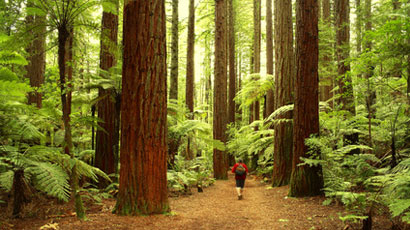The Healing Power of Nature

In today’s fast-paced world, almost everything we ingest is artificial, processed and synthetic, be it food or medication. Even when it comes to exercising, many of us choose to walk on the treadmill, or take a dip in the public pool, instead of heading towards the park or the ocean. Smoking and drinking have probably becomes the most common ways to reduce stress and anxiety, especially with working individuals. Needless to say, the air we breathe in is far from pure, at least in urban areas! And when it comes to curing any ailment, even something as mild as a common cold, many of us waste no time in popping a pill. But did you know that many of your health problems can be treated without a trip to the doctor or the pharmacy?
Fortunately, many people are now realizing the healing powers that nature can have on their bodies. After accepting homeopathy and herbal therapy, for treating several different types of ailments, many individuals are now exploring the benefits of Eco-therapy.
In simple terms, Eco-therapy can be described as a form of natural treatment, which encourages people to build mutually-beneficial relationships with nature. Those who have been undergoing this therapy make an attempt to use their mind, heart & senses to interact with the world. While many people practice Eco-therapy in different ways, this treatment requires you to:
- Head off to the woods or a garden
- Sit beside some flowing water
- Watch the scenery when you are traveling by car or train
- Interact with domestic animals like cats, dogs and horses
- Embrace activities like gardening as well as tending plants and watching them
Basically, you need to get involved with different types of living species other than your own.
Intuitively, many of us have been aware of the healing power of nature for a very long time and recent research proves that we have been right all along. Nature can have a positive impact on your body in numerous ways:
- Medical Benefits: Just looking at nature can help your body heal faster. Research has shown that patients in hospitals experience less pain and recover faster, if they have access to the views and sounds of nature. Even looking at murals of natural scenery and listening to recorded sounds of nature can have a similar effect on your recovery process.
- Emotional Benefits: Continuous focus on everyday tasks, at work and home can drain you, causing you to feel irritable, fatigued and stressed. Nature can increase your sense of overall well being with its restorative effect. Adults and teens claim to feel more relaxed after spending time outdoors. Taking part in a variety of activities like jogging in the park, camping in the woods or swimming in the river, can help you feel more self-confident and patient.
- Therapeutic Benefits: Interacting with nature for just a few hours each day can help you combat some serious health issues, like depression and anxiety. A recent study conducted in England showed that people experienced a reduction in depression when they walked outside, but experienced little improvement or even worsening of their symptoms when they went walking in a shopping mall for the same amount of time. In certain schools, teachers are encouraged to take hyperactive students outside for a brief walk, so that they can concentrate on classroom activities for the rest of the day.
While you do not really need a doctor’s approval to take a walk in the park, it is always a good idea to keep your healthcare provider informed about any lifestyles changes that you are planning to make.
Resources:
- Mitten, D. (2009). Under our noses: The Healing power of nature, Taproot Journal 19(1) 20-26
- Gierlach-Spriggs, N., Kaufman, R. E., and Warner, Jr. S. B. (1998). Restorative garden: The healing landscape. New Haven: Yale University Press
- Maller, C., Townsend, M., Pryor, A., Brown, P., & St Leger, L. (2006). Healthy nature, healthy people: 'Contact with nature' as an upstream health promotion intervention for populations. Health Promotion International, 21(1), 45-54